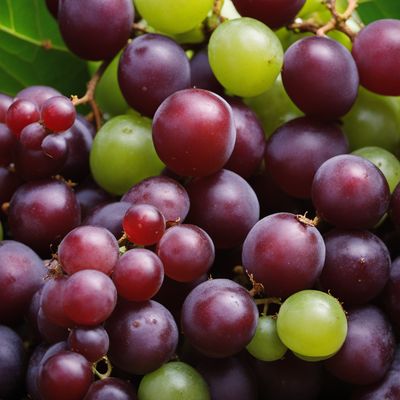
Ingredient
Maprangs
The Exotic Tanginess of Maprangs
Maprangs are small, round fruits with a thin, smooth skin that ranges in color from green to yellow. They have a juicy, translucent flesh that is both sweet and tangy, similar to a combination of lime and mango. The flavor is refreshing and slightly acidic, making it a popular choice for beverages, jams, and desserts.
Origins and history
Maprangs are native to Southeast Asia, particularly Thailand and Malaysia, where they have been cultivated for centuries. They are highly regarded for their culinary and medicinal properties, often used in traditional Thai cuisine and herbal remedies. These fruits are also known for their vibrant color, which adds visual appeal to various dishes.
Nutritional information
Maprangs are low in calories and rich in vitamin C, providing a boost to the immune system. They also contain antioxidants and dietary fiber, promoting overall health and digestion.
Allergens
There are no known allergens associated with maprangs.
How to select
When selecting maprangs, look for fruits that are firm and free from blemishes or bruises. The skin should be smooth and vibrant in color, indicating freshness. Avoid fruits that are overly soft or have a dull appearance.
Storage recommendations
To maintain the freshness of maprangs, store them in a cool, dry place away from direct sunlight. They can be kept at room temperature for a few days or refrigerated for up to a week. It is recommended to consume maprangs when they are ripe for the best flavor experience.
How to produce
Maprangs can be grown in tropical or subtropical regions with warm temperatures and well-drained soil. They thrive in full sun and require regular watering. It is best to propagate maprangs from seeds or by grafting onto a compatible rootstock.
Preparation tips
Maprangs can be enjoyed fresh as a snack or used in various culinary preparations. They are commonly used in beverages like juices, smoothies, and cocktails, adding a tangy twist. Maprangs are also used in jams, jellies, and desserts such as pies, tarts, and sorbets, providing a burst of tropical flavor.
Culinary uses
Maprangs are commonly used in Thai cuisine, particularly in salads, sauces, and marinades. They are also popular in Malaysian cuisine, where they are used in curries and stir-fries. Additionally, maprangs are utilized in traditional medicine and herbal remedies in Southeast Asia.
Availability
Maprangs are primarily cultivated in Southeast Asian countries such as Thailand, Malaysia, and Indonesia. They are also found in other tropical regions around the world.
More ingredients from this category » Browse all

Cashew apples
The Tropical Delight of Cashew Apples

Santols
The Tropical Delight: Exploring the Exotic Santols

Babacos
Exotic Delight: Babacos

Nonis
The Exotic Powerhouse

Bilimbis
Tropical Tang: Exploring the Unique Flavor of Bilimbis

Jaboticabas
The Exotic Jewel of the Tropics: Exploring the Enchanting World of Jaboticabas

Ambarellas
The Tropical Delight

Aonlas
The Tangy Delight: Exploring the Unique Flavors of Aonlas

Malay pommarosas
The Exotic Delight: Malay Pommarosas - A Tropical Twist for Your Taste Buds

Purple mombins
The Vibrant Delight: Exploring the World of Purple Mombins

Dracontomelon duperreanum fruits
The Exotic Delight: Dracontomelon Fruits

Natal plums
The Exotic Gems: Natal Plums